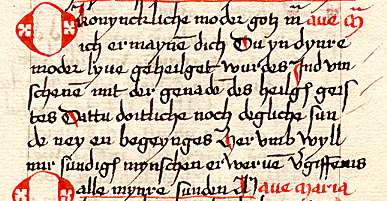Script Type : minuscule cursive
Script Family : Gothic
Date : late 15th or 16th century
Location : Netherlands or Germany
Function : book hand



























Distinctive letters: This segment of a prayer from a book of hours is written in the vernacular, in a dialect of Dutch or German, in a cursive Gothic script. While the letter forms are somewhat irregular and it has an untidy appearance, the letters are, for the most part, relatively clearly formed. They are a bit variable, and the examples above are chosen from the clearest examples. While the letters are mostly well separated, sometimes they merge to almost form ligatures, particularly the de combination. While there are no incomprehensible rows of minims, it can sometimes be difficult to distinguish n from u. There are some abbreviations.
Ascenders and descenders tend to be a trifle exaggerated, but not looped, so that the tall form of s is very elongated, while the short form is twirled into closed loops.
The letter a is the single chambered form, d has the backsloping Gothic form but taller and straighter, g resembles the Gothic form but with an open descender.
There are two forms of r, including the simplified form found generally after vowels. The letters u and v both come in two forms, but these distinguish their position in the word rather than differentiating them.
Being a Germanic language, k, w and z are present, w being literally in the form of a double u and much less extravagant than in English cursive scripts, while z has a long curling descender.
but there are no examples of j or q.
Pass the cursor slowly down the lines of text to get a quick instant transcript, and if that doesn't make too much sense, proceed to the paleography exercises to find out what it's all about.
Paleography
exercises using Flash ![]()
Requires at least the Flash 5 plugin
If you are looking at this page without frames, there is more information about medieval writing to be found by going to the home page (framed) or the site map (no frames).